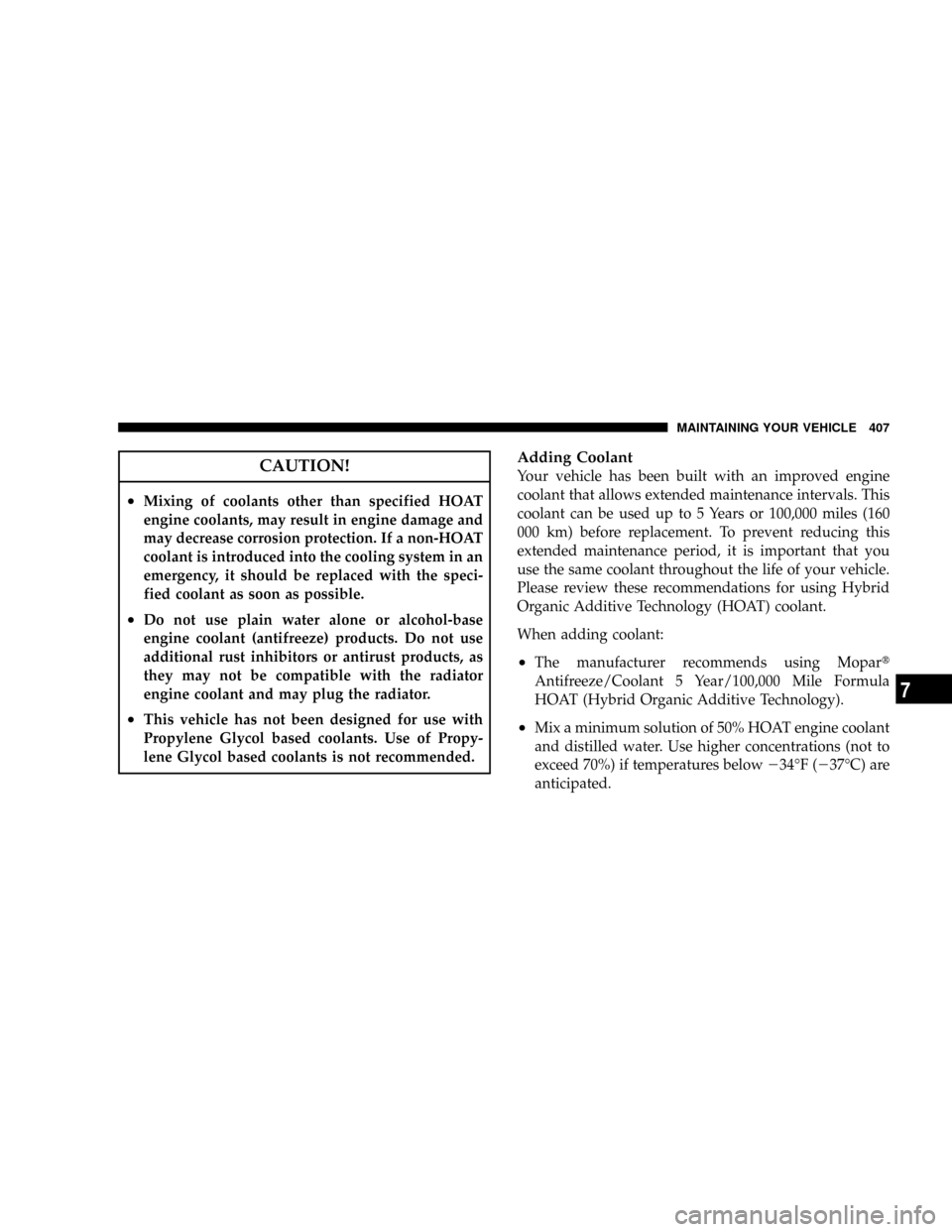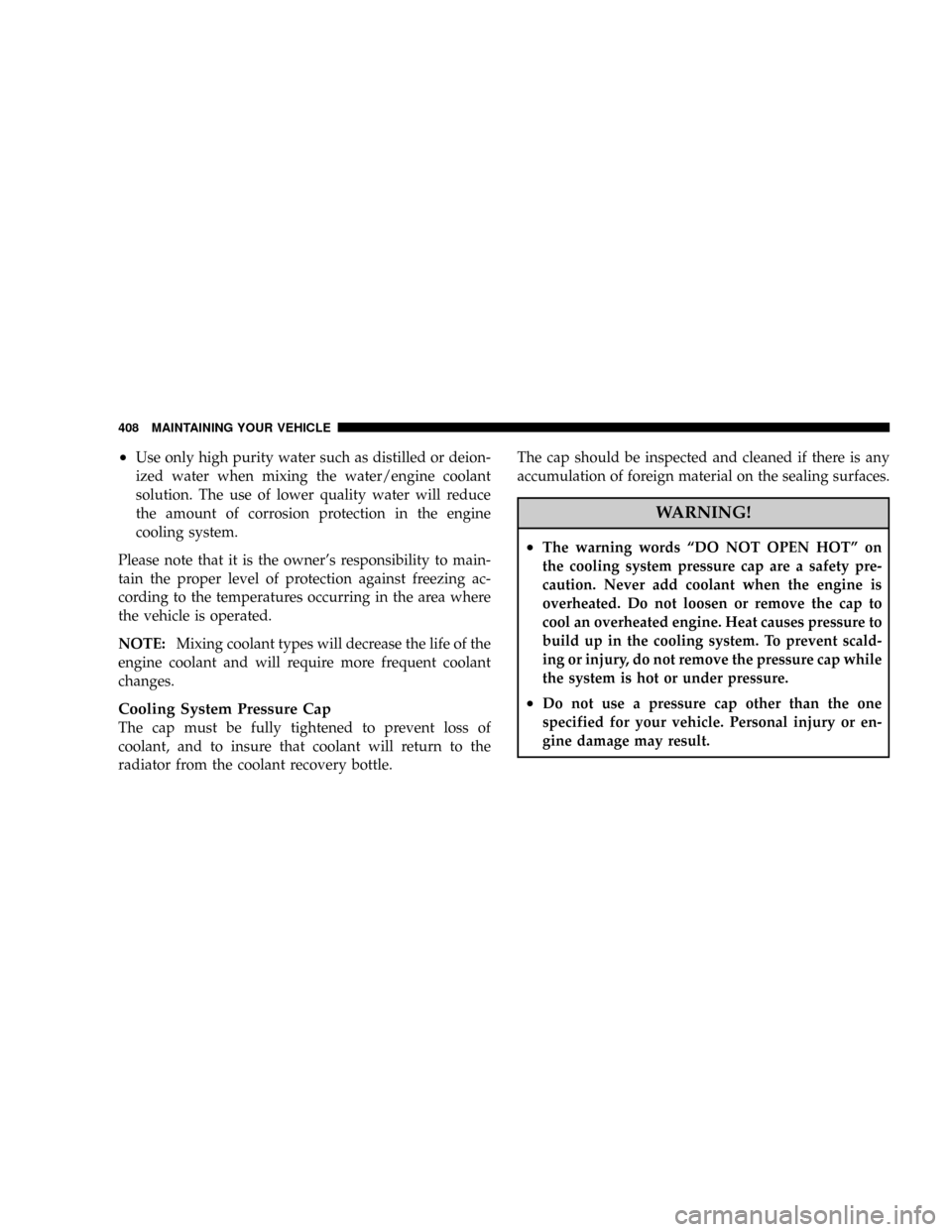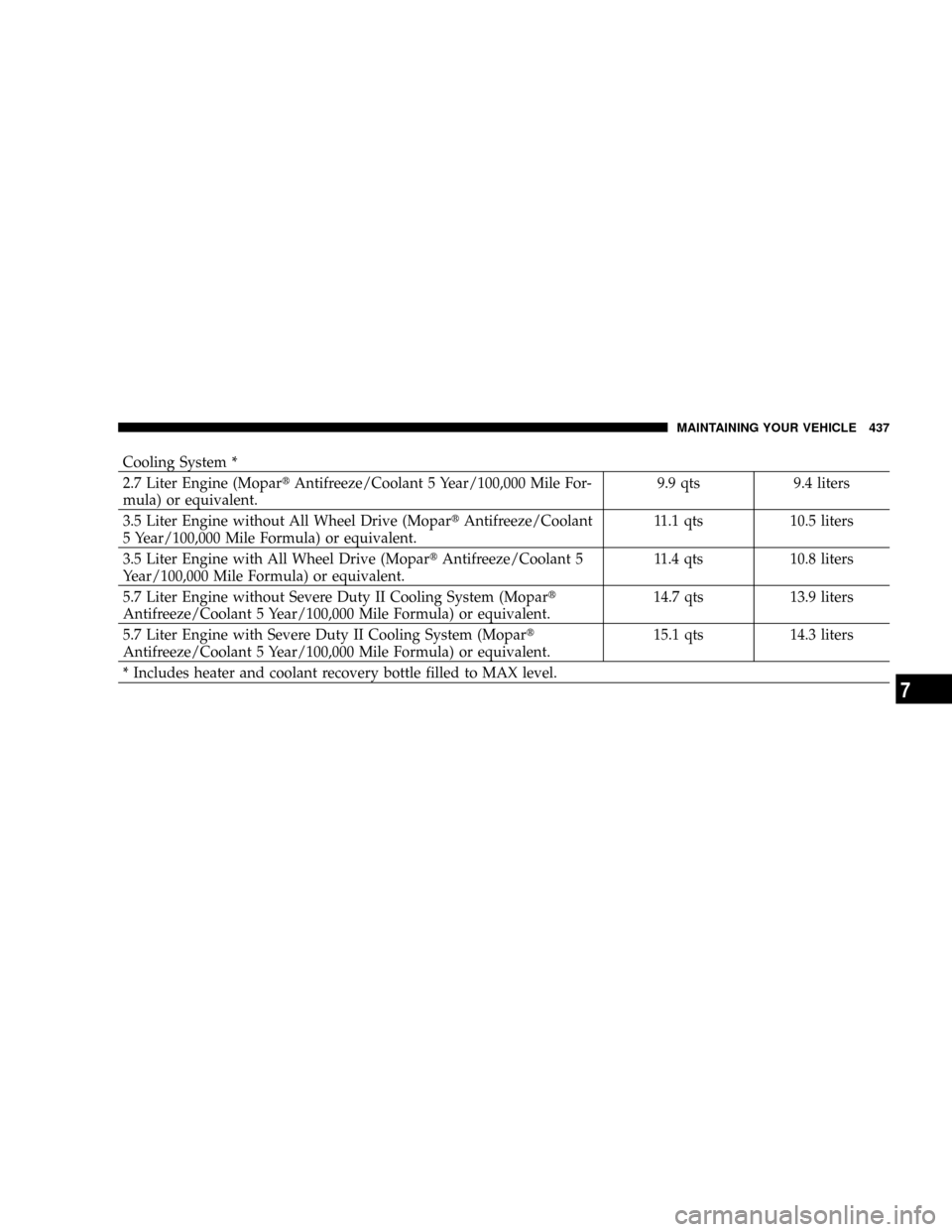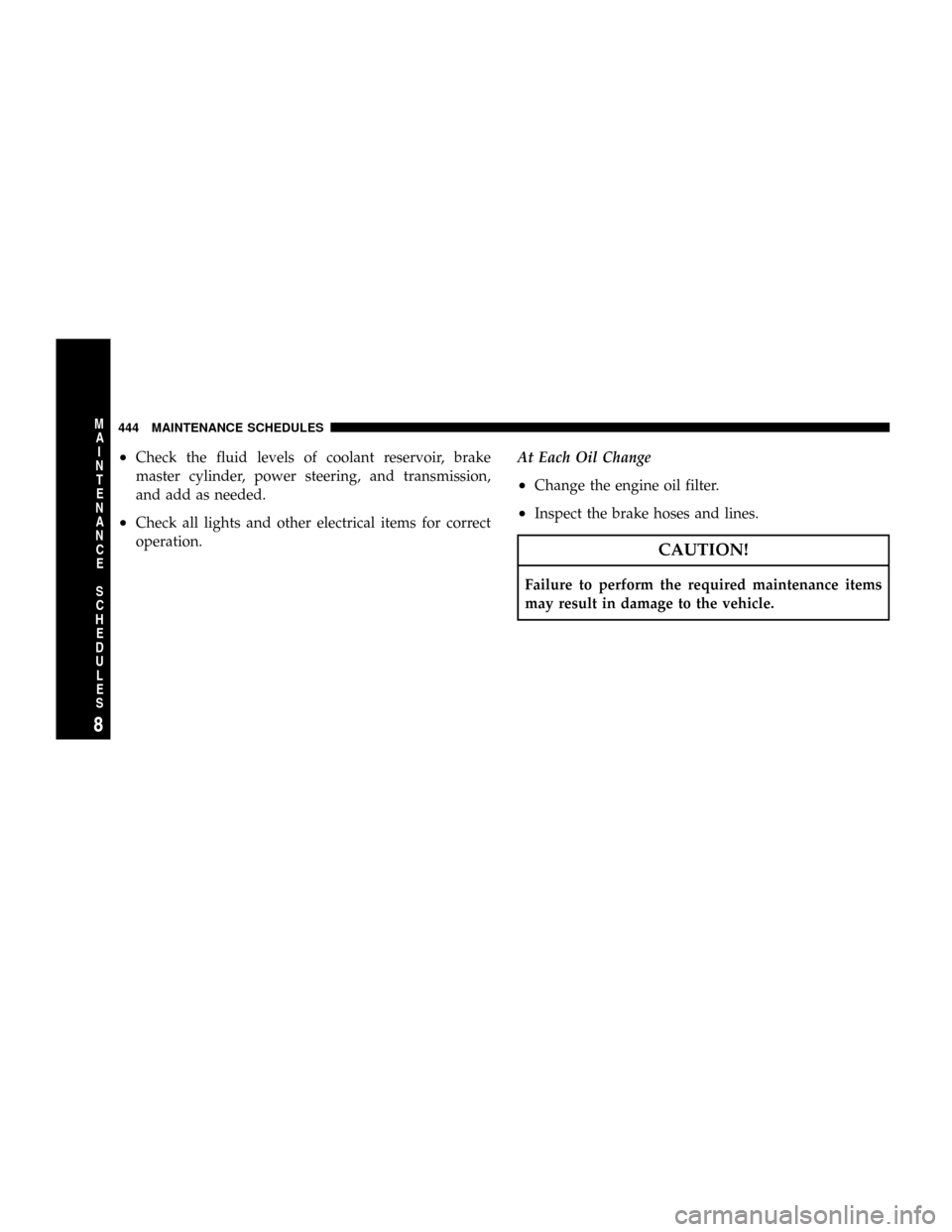engine coolant DODGE MAGNUM 2008 1.G User Guide
[x] Cancel search | Manufacturer: DODGE, Model Year: 2008, Model line: MAGNUM, Model: DODGE MAGNUM 2008 1.GPages: 482, PDF Size: 6.94 MB
Page 406 of 482

Coolant Checks
Check engine coolant (antifreeze) protection every 12
months (before the onset of freezing weather, where
applicable). If coolant is dirty or rusty in appearance, the
system should be drained, flushed, and refilled with
fresh coolant. Check the front of the A/C condenser for
any accumulation of bugs, leaves, etc. If dirty, clean by
gently spraying water from a garden hose vertically
down the face of the condenser.
Check the coolant recovery bottle tubing for brittle rub-
ber, cracking, tears, cuts, and tightness of the connection
at the bottle and radiator. Inspect the entire system for
leaks.
With the engine at normal operating temperature (but
not running), check the cooling system pressure cap for
proper vacuum sealing by draining a small amount of
coolant from the radiator drain cock. If the cap is sealing
properly, the engine coolant (antifreeze) will begin todrain from the coolant recovery bottle. DO NOT RE-
MOVE THE COOLANT PRESSURE CAP WHEN THE
COOLING SYSTEM IS HOT.
Cooling System Ð Drain, Flush, and Refill
The system should be drained, flushed, and refilled at the
intervals shown in the ªMaintenance Scheduleº in Sec-
tion 8 of this manual.
If the solution is dirty or contains a considerable amount
of sediment, clean and flush with a reliable cooling
system cleaner. Follow with a thorough rinsing to remove
all deposits and chemicals. Properly dispose of old
antifreeze solution.
Selection of Coolant
Use only the manufacturer's recommended coolant. Re-
fer to ªFluids, Lubricants, and Genuine Partsº for the
correct coolant type.
406 MAINTAINING YOUR VEHICLE
Page 407 of 482

CAUTION!
²Mixing of coolants other than specified HOAT
engine coolants, may result in engine damage and
may decrease corrosion protection. If a non-HOAT
coolant is introduced into the cooling system in an
emergency, it should be replaced with the speci-
fied coolant as soon as possible.
²Do not use plain water alone or alcohol-base
engine coolant (antifreeze) products. Do not use
additional rust inhibitors or antirust products, as
they may not be compatible with the radiator
engine coolant and may plug the radiator.
²This vehicle has not been designed for use with
Propylene Glycol based coolants. Use of Propy-
lene Glycol based coolants is not recommended.
Adding Coolant
Your vehicle has been built with an improved engine
coolant that allows extended maintenance intervals. This
coolant can be used up to 5 Years or 100,000 miles (160
000 km) before replacement. To prevent reducing this
extended maintenance period, it is important that you
use the same coolant throughout the life of your vehicle.
Please review these recommendations for using Hybrid
Organic Additive Technology (HOAT) coolant.
When adding coolant:
²The manufacturer recommends using Mopart
Antifreeze/Coolant 5 Year/100,000 Mile Formula
HOAT (Hybrid Organic Additive Technology).
²Mix a minimum solution of 50% HOAT engine coolant
and distilled water. Use higher concentrations (not to
exceed 70%) if temperatures below234ÉF (237ÉC) are
anticipated.
MAINTAINING YOUR VEHICLE 407
7
Page 408 of 482

²Use only high purity water such as distilled or deion-
ized water when mixing the water/engine coolant
solution. The use of lower quality water will reduce
the amount of corrosion protection in the engine
cooling system.
Please note that it is the owner's responsibility to main-
tain the proper level of protection against freezing ac-
cording to the temperatures occurring in the area where
the vehicle is operated.
NOTE:Mixing coolant types will decrease the life of the
engine coolant and will require more frequent coolant
changes.
Cooling System Pressure Cap
The cap must be fully tightened to prevent loss of
coolant, and to insure that coolant will return to the
radiator from the coolant recovery bottle.The cap should be inspected and cleaned if there is any
accumulation of foreign material on the sealing surfaces.
WARNING!
²The warning words ªDO NOT OPEN HOTº on
the cooling system pressure cap are a safety pre-
caution. Never add coolant when the engine is
overheated. Do not loosen or remove the cap to
cool an overheated engine. Heat causes pressure to
build up in the cooling system. To prevent scald-
ing or injury, do not remove the pressure cap while
the system is hot or under pressure.
²Do not use a pressure cap other than the one
specified for your vehicle. Personal injury or en-
gine damage may result.
408 MAINTAINING YOUR VEHICLE
Page 409 of 482

Disposal of Used Coolant
Used ethylene glycol based engine coolant is a regulated
substance requiring proper disposal. Check with your
local authorities to determine the disposal rules for your
community. To prevent ingestion by animals or children,
do not store ethylene glycol based engine coolant in open
containers or allow it to remain in puddles on the
ground. If ingested by a child, contact a physician
immediately. Clean up any ground spills immediately.
Coolant Level
The coolant bottle provides a quick visual method for
determining that the coolant level is adequate. With the
engine off and cold, the level of the coolant in the bottle
should be between the ranges indicated on the bottle.
The radiator normally remains completely full, so there is
no need to remove the radiator cap unless checking for
coolant freeze point or replacing coolant. Advise yourservice attendant of this. As long as the engine operating
temperature is satisfactory, the coolant bottle need only
be checked once a month.
When additional coolant is needed to maintain the
proper level, it should be added to the coolant bottle. Do
not overfill.
Points To Remember
NOTE:When the vehicle is stopped after a few miles
(kilometers) of operation, you may observe vapor coming
from the front of the engine compartment. This is nor-
mally a result of moisture from rain, snow, or high
humidity accumulating on the radiator and being vapor-
ized when the thermostat opens, allowing hot coolant to
enter the radiator.
If an examination of your engine compartment shows no
evidence of radiator or hose leaks, the vehicle may be
safely driven. The vapor will soon dissipate.
MAINTAINING YOUR VEHICLE 409
7
Page 410 of 482

²Do not overfill the coolant recovery bottle.
²Check coolant freeze point in the radiator and in the
coolant recovery bottle. If antifreeze needs to be
added, contents of coolant recovery bottle must also be
protected against freezing.
²If frequent coolant additions are required, or if the
level in the coolant recovery bottle does not drop when
the engine cools, the cooling system should be pres-
sure tested for leaks.
²Maintain coolant concentration at 50% HOAT engine
coolant (minimum) and distilled water for proper
corrosion protection of your engine, which contains
aluminum components.
²Make sure that the radiator and coolant recovery
bottle overflow hoses are not kinked or obstructed.
²Keep the front of the radiator clean. If your vehicle is
equipped with air conditioning, keep the front of the
condenser clean, also.
²Do not change the thermostat for summer or winter
operation. If replacement is ever necessary, install
ONLY the correct type thermostat. Other designs may
result in unsatisfactory coolant performance, poor gas
mileage, and increased emissions.
Hoses and Vacuum/Vapor Harnesses
Inspect surfaces of hoses and nylon tubing for evidence
of heat and mechanical damage. Hard or soft spots,
brittle rubber, cracking, tears, cuts, abrasions, and exces-
sive swelling indicate deterioration of the rubber.
Pay particular attention to those hoses nearest to high
heat sources such as the exhaust manifold. Inspect hose
routing to be sure hoses do not come in contact with any
heat source or moving component, which may cause heat
damage or mechanical wear.
410 MAINTAINING YOUR VEHICLE
Page 437 of 482

Cooling System *
2.7 Liter Engine (MopartAntifreeze/Coolant 5 Year/100,000 Mile For-
mula) or equivalent.9.9 qts 9.4 liters
3.5 Liter Engine without All Wheel Drive (MopartAntifreeze/Coolant
5 Year/100,000 Mile Formula) or equivalent.11.1 qts 10.5 liters
3.5 Liter Engine with All Wheel Drive (MopartAntifreeze/Coolant 5
Year/100,000 Mile Formula) or equivalent.11.4 qts 10.8 liters
5.7 Liter Engine without Severe Duty II Cooling System (Mopart
Antifreeze/Coolant 5 Year/100,000 Mile Formula) or equivalent.14.7 qts 13.9 liters
5.7 Liter Engine with Severe Duty II Cooling System (Mopart
Antifreeze/Coolant 5 Year/100,000 Mile Formula) or equivalent.15.1 qts 14.3 liters
* Includes heater and coolant recovery bottle filled to MAX level.
MAINTAINING YOUR VEHICLE 437
7
Page 438 of 482

FLUIDS, LUBRICANTS, AND GENUINE PARTS
Engine
Component Fluids, Lubricants, and Genuine Parts
Engine Coolant MopartAntifreeze/Coolant 5 Year/100,000 Mile Formula HOAT (Hybrid Or-
ganic Additive Technology) or equivalent
Engine Oil (2.7 Liter) Use API Certified SAE 5W-20 Engine Oil meeting the requirements of
DaimlerChrysler Material Standard MS-6395. Refer to the engine oil fill cap
for correct SAE grade.
Engine Oil (3.5 Liter) Use API Certified SAE 10W-30 Engine Oil meeting the requirements of
DaimlerChrysler Material Standard MS-6395. Refer to the engine oil fill cap
for correct SAE grade.
Engine Oil (5.7 Liter) Use API Certified SAE 5W-20 Engine Oil meeting the requirements of
DaimlerChrysler Material Standard MS-6395. Refer to the engine oil fill cap
for correct SAE grade.
Spark Plugs (2.7L) RE14PMC5 (Gap.050 in [1.27 mm])
Spark Plugs (3.5L) ZFR5LP-13G (Gap.050 in [1.27 mm])
Spark Plugs (5.7L) REC14MCC4 (Gap.043 in [1.1 mm])
Oil Filter (2.7 Liter) Mopart05281090 or equivalent.
438 MAINTAINING YOUR VEHICLE
Page 444 of 482

²Check the fluid levels of coolant reservoir, brake
master cylinder, power steering, and transmission,
and add as needed.
²Check all lights and other electrical items for correct
operation.At Each Oil Change
²Change the engine oil filter.
²Inspect the brake hoses and lines.
CAUTION!
Failure to perform the required maintenance items
may result in damage to the vehicle.
444 MAINTENANCE SCHEDULES
8
M
A
I
N
T
E
N
A
N
C
E
S
C
H
E
D
U
L
E
S
Page 446 of 482

Perform Maintenance Every(Where time and mileage
are listed, follow the interval that occurs first.)
Maintenance Items Miles Kilometers or Months
Replace the engine air cleaner filter. 30,000 50 000 30
Inspect the transfer case fluid Ð All Wheel Drive
(AWD).30,000 50 000 30
Replace the spark plugs on 5.7L engines.30,000 50 000 30
Change the rear axle fluid if using your vehicle for
any of the following: police, taxi, fleet, off-road, or fre-
quent trailer towing.48,000 80 000 48
Change the automatic transmission fluid & filter if
using your vehicle for any of the following: police,
taxi, fleet, or frequent trailer towing.60,000 100 000 60
Change the transfer case fluid if using your vehicle for
any of the following: police, taxi, fleet, off-road, or fre-
quent trailer towing Ð All Wheel Drive (AWD).60,000 100 000 60
Inspect and replace the PCV valve if necessary.90,000 150 000 90
Flush and replace the engine coolant. 102,000 170 000 60
446 MAINTENANCE SCHEDULES
8
M
A
I
N
T
E
N
A
N
C
E
S
C
H
E
D
U
L
E
S
Page 460 of 482

About Your Brakes....................290,292
ABS (Anti-Lock Brake System).............. 293
Adding Engine Coolant (Antifreeze).......... 407
Adding Fuel........................... 336
Adding Rear Washer Fluid................. 261
Adding Washer Fluid...............133,261,404
Additives, Fuel......................... 334
Adjustable Pedals....................... 135
Air Cleaner, Engine (Engine Air Cleaner Filter) . . . 396
Air Conditioner Maintenance............... 400
Air Conditioning.....................249,251
Air Conditioning Controls................. 249
Air Conditioning Filter.................258,401
Air Conditioning, Operating Tips............ 259
Air Conditioning Refrigerant.............400,401
Air Conditioning System..........249,251,252,400
Air Pressure, Tires....................182,312
Airbag................................ 52
Airbag Deployment.....................57,61Airbag Light.....................58,63,78,177
Airbag Maintenance....................... 63
Airbag, Side..........................53,59
Airbag, Window (Side Curtain).............53,59
Alarm, Panic............................ 24
Alarm (Security Alarm).................18,182
Alarm System (Security Alarm)............... 18
Alignment and Balance................... 319
All Wheel Drive (AWD)................287,415
Alterations/Modifications, Vehicle............. 7
Antenna, Satellite Radio................... 237
Antifreeze (Engine Coolant)...........406,407,436
Disposal............................ 409
Anti-Lock Brake System (ABS).............. 293
Anti-Lock Warning Light...............183,294
Anti-Theft Security Alarm (Theft Alarm)........ 18
Anti-Theft System....................... 182
Appearance Care........................ 416
Arming Theft System (Security Alarm)......... 18
460 INDEX